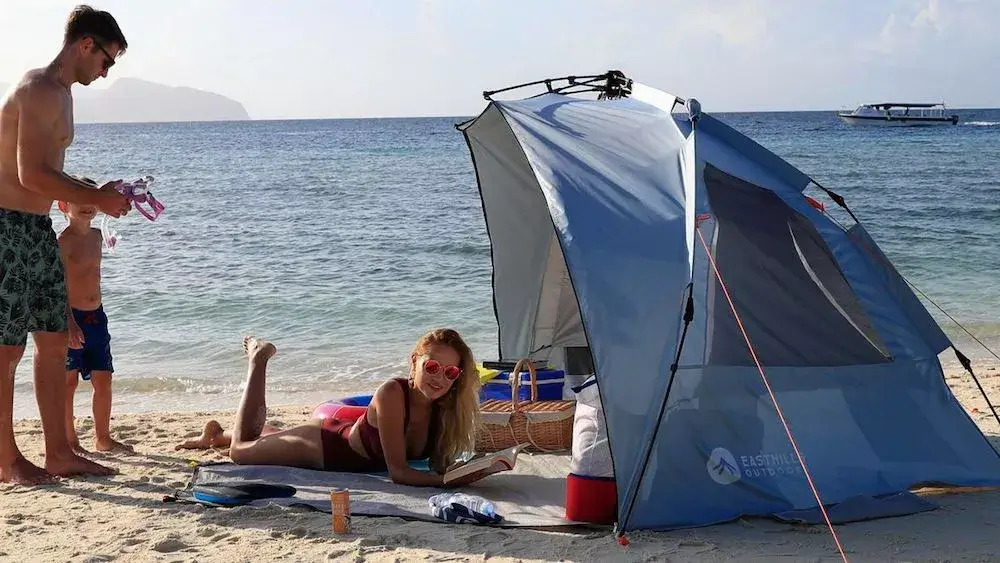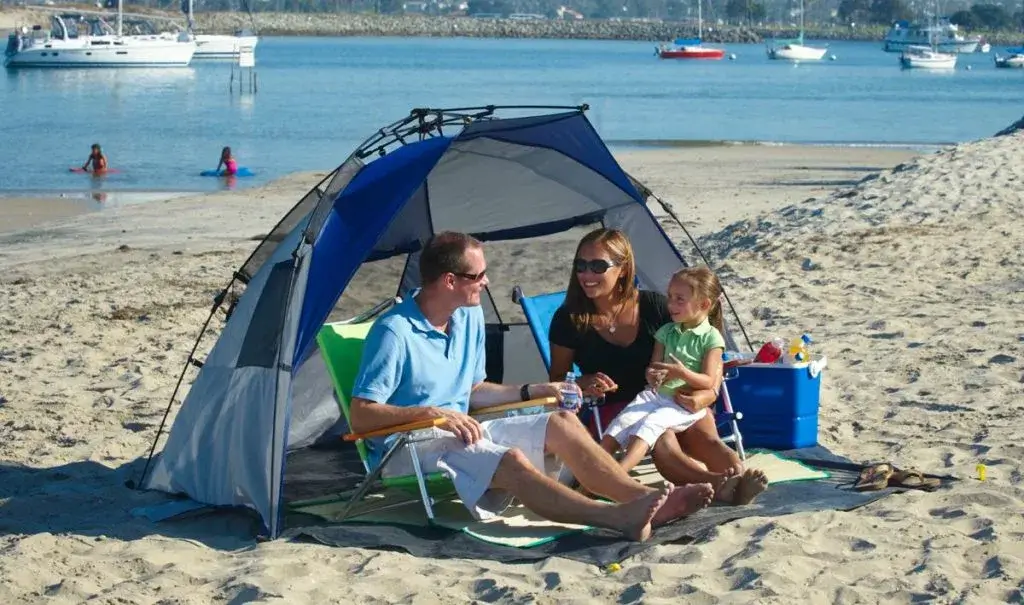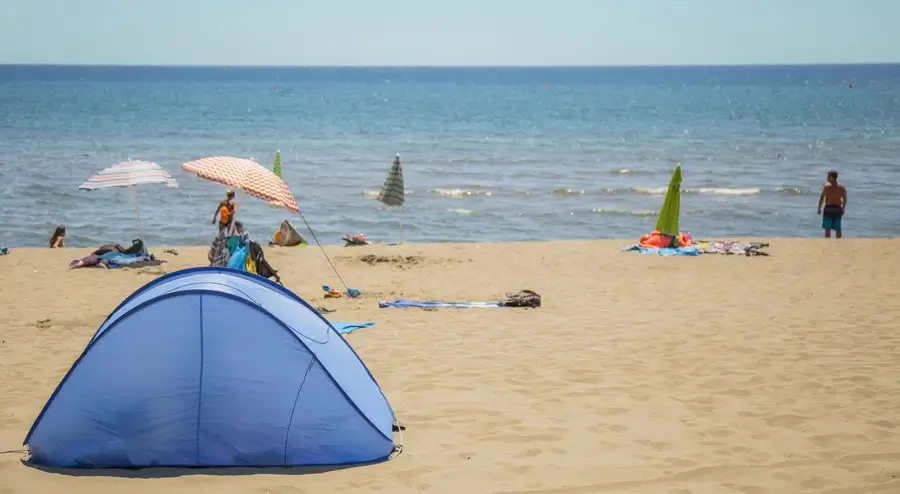Can you put a tent on the beach? This is one of those questions we’ve all asked ourselves once or twice. But, if you think about it, it’s an interesting question and one worth discussing for a few minutes.
In this blog post, we will explore some of the considerations that would go into such an endeavor and then give our verdict at the end.
But, wait…Is it possible to put up a tent on the beach? Is it legal?
Depending on where the beach is, they may not allow camping. This will be an issue in some places and not so many others -Small beaches don’t usually have too many people either, which means that you could get away with it if nobody complains or calls security.
If there’s a lifeguard tower nearby, they might notice your tent and come to tell you that you can’t sleep there -If families frequent the beach, then they might not like someone camping nearby their children’s toys.
Campsites on beaches are standard in Europe. It will be interesting to see if something similar becomes popular here.
Can You Put a Tent on the Beach?

Can you put a tent on the beach? The answer is yes, but there are some things that you need to keep in mind. First, make sure that you choose a campsite near enough to water so that you can easily wash off sand and salt.
Also, be aware of any restrictions on camping at the beach – some places don’t allow it at all, while others have specific rules about where you can and cannot set up a tent.
If there’s a chance of bad weather, it might be best to pack up your things and leave. Have fun on your next camping trip.
-You can put a tent up on the beach if there are no rules against it -Make sure that the tent is waterproof and can handle wind gusts if you want to camp on a beach -Bring things like insect repellent, sunscreen, water, food, etc. with you on your camping trip.
-You should pack up any belongings if rain or high winds are expected at the beach -Make sure that you don’t camp in a spot with too much sand and debris.
Also Read: 3 Season vs 4 Season Tent
Popular Beaches You Can Camp On Overnight
Camping overnight is not allowed at many beaches across the world. There are a few places where it’s legal, though, and even more that don’t have any rules about camping on them. Some of these popular spots include:
- Sleeping Bear Dunes National Lakeshore in Michigan
- Cape Disappointment State Park in Washington
- Point Reyes National Seashore in California
- Assateague Island National Seashore in Maryland and Virginia
- Isle of Palms County Park in South Carolina
- North Myrtle Beach, South Carolina
- Pismo State Beach in California
- Grayton Beach State Park in Florida
- Hilton Head Island in South Carolina
- Jekyll Island State Park in Georgia
- Ocracoke Island in North Carolina
- Ocean City in Maryland
- Cana Island in Maine
Tips for Camping in a Tent on the Beach
-Make sure that the tent is waterproof and can handle wind gusts. If it’s not, then your camping trip will be miserable
-Bring a tarp to put under the tent in case of rain – this will help keep the floor of the tent dry
-Pack extra stakes and sandbags to help secure the tent against wind gusts
-Pack a canopy or beach umbrella to provide some shade – the sun can be brutal on the sand and during the late afternoon/evening hours
-Pack insect repellent, sunscreen, and hats. The bugs can be bad at night, and the sun is no joke
-Make sure that you have enough drinking water and food. It can be tough to find a store on the beach, especially at night
-Pack a flashlight or headlamp – it will help you get around at night without having to worry about stubbing your toe on a rock
-If there’s a chance of bad weather, pack up your things and leave. There’s no sense in camping in the rain or wind.
How to Protect a Tent on the Beach

If you’re looking to camp on the beach, it’s important to ensure your tent is stable and secure. Follow these steps to make sure your camping trip goes smoothly:
- Dig a hole in the sand for each corner of your tent. Make sure the holes are deep enough that your stakes will be secure.
- Place your stakes in the holes, and use a mallet or rock to hammer them into the ground.
- Spread out your tent fabric and stake it down in each corner. Make sure the fabric is taut before you move on to the next step.
- Use sandbags or rocks to weigh down the edges of your tent. This will prevent the wind from catching under your fabric and sending it flying off into the ocean.
- Make sure all of your guy lines are tight before you go to sleep, so everything stays in place overnight.
What’s the Best Way to Stop a Tent from Escaping?
Tent stakes are one of the most important parts of your tent. Not only do they help give you an excellent foundation to which you can attach guy lines for added stability, but they also help keep your shelter in place while minimizing stress on the fabric and poles during high winds.
The best way to anchor down your tent is with heavy-duty stakes like these from MSR. Their Y-stakes are made to be used in the hard ground such as rocks and grass, while the V-shaped points help get better penetration into softer surfaces.
If you’re looking for something a bit more compact, look no further than this tent stake sack, which allows you to carry up to 20 of them on your next camping trip.
If there’s no hard ground available, or if you’re trying to set up camp in an area with a lot of loose sand, then you’ll need to bring along some extra gear to keep your tent from blowing away.
One option is to use large rocks as anchors, but this can be cumbersome, especially when you try to move around your campsite or need to get back inside the tent during a storm.
Instead, look for something like this sand stake kit which includes 12 of these Y-shaped stakes that will keep your shelter in place while making it easy enough for everyone to use without any hassle.
Another option is to use an all-purpose sand stake kit like this one from Coleman, which comes with two Y-shaped stakes and four V-stakes for use in soft ground.
The best part of these is that they collapse down into short sections (11″) to make it easy enough to carry them inside your tent or bag without an issue while also keeping you prepared if the ground happens to become loose.
What Are the Best Tent Pegs for Use in the Sand?
If you’re looking for the best tent pegs for sand, there are a few factors to consider. The most important thing is to find solid and durable pegs to hold your tent in place, even in windy conditions.
Another consideration is size – you’ll want pegs that are small enough to fit easily into the sand but big enough to provide a good grip.
A few different types of tent pegs work well in sand, including Y-shaped pegs, screw pegs, and sand anchors. Y-shaped pegs are probably the most popular type for camping on the beach, as they’re strong and easy to use.
Screw pegs work by turning a spike into the sand and are great for getting a snug fit. Sand anchors, as the name suggests, anchor your tent in place with weights or stakes on each side – these are a great option if you’re camping in a particularly windy area.
Whatever type of peg you choose, make sure to test it out in advance to ensure that it’s strong enough for your needs. A little preparation can go a long way towards making your beach camping trip a success.
How Can You Reduce the Weight of a Tent?

A tent is not always as sturdy or stable as you think. Many factors come into play when determining how to ensure your shelter stays put on the sand, but there are two main things to consider: weight and anchoring tactics.
Put too much weight into one area, and you could have trouble with stability. This is why tents are typically used for camping, where there are trees available to help provide supports at each corner of your tent.
Without trees, you can try using rocks or other heavy items to weigh down your tent’s footprint on the ground.
There are many ways to do this, but each place is different, so know what works beforehand. For example, dunes tend to be more stable with less weight, while rocky areas require a bit more work to keep the tent from blowing away.
You can also try staking down your tent with long stakes that are driven into the ground through a small hole in one of the corners, but this is not always reliable as there may be too much sand around for it to go deep enough and hold tightly, allowing high winds to catch under your shelter and send it flying.
How to Prevent Sand from Getting into Your Tent
When it comes to the beach, people most commonly think about sand. Unfortunately, it gets in everything and doesn’t go away.
The same can be said for your tent when you decide to spend a day at the beach with friends or family members. This section will discuss how you can prevent sand from getting inside your tent while at the beach.
The first step is to get a footprint for your tent. This works so well because the footprint goes underneath your regular camping ground and prevents any sand from getting into it while you are setting up or taking down camp.
This should be done every time before you set up camp, especially when there’s likely going to be a lot of sand around.
Another thing you can do is use a tent tarp. This will also go underneath your regular camping ground, but it has the added benefit of protecting your tent from rain or any other type of weather while you are at the beach.
Tarps can be found at most outdoor stores and tend to be very affordable.
Can You Put A Tent On The Beach: Our Verdict
Overall, we think it is possible to put a tent on the beach under the right However, ifrcumstances. If you live near the ocean and want to enjoy the sound and smell of waves crashing while sleeping, then it’s worth considering.
Just be aware of the risks and take all of the necessary precautions. Happy camping!

